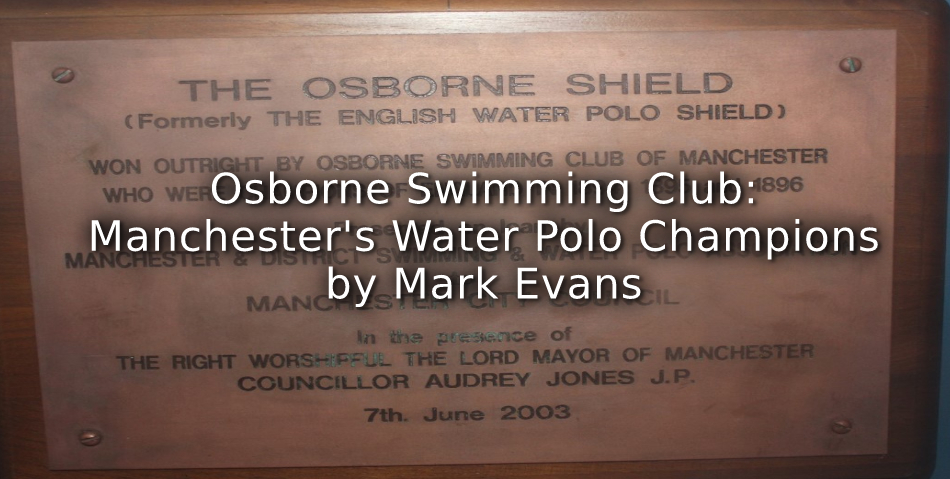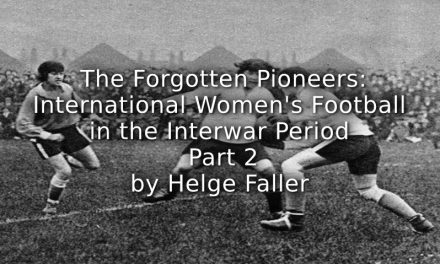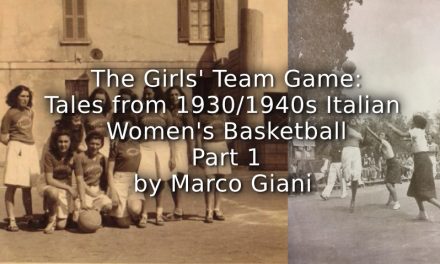Introduction
As a Mancunian I have always been interested in the sporting history of Manchester and the surrounding area. Sports such as football, cricket and rugby, both codes, have helped to shape and define the city. However, less high profiled sports have also played an important part in the cities’ history. Swimming and water polo are two of these sports.
In the late nineteenth and early twentieth century Manchester was the home of one of the most successful swimming and water polo clubs in the sport’s history and many of the most successful swimmers and players of the era were members of this once famous club. In fact, many of them came from the city or the just outside. The club was Osborne Swimming Club and in this article I will look at some of their water polo achievements and at some of the players who made the club so successful.
Newspaper coverage of the sport of water polo at this time was plentiful and the British Newspaper Archive site has been invaluable in learning more about the club and the players
The swimming achievements of the club were also very impressive and hopefully will be covered in a follow up article.
Osborne Swimming Club
Osborne Swimming Club was based at the Osborne Street baths situated on Osborne Street, Collyhurst, just north of Manchester city centre. The baths were opened on June 14th 1883 by the Mayor of Manchester, Alderman Hopkinson. A newspaper report noted,
There was a crowded attendance inside the baths and outside the streets were thickly lined with people. 1
In his speech the Mayor said,
He was sure the dense population of that neighbourhood would welcome the establishment of that institution in their midst. 2
At the time the area was certainly densely populated with a number of factories close by and the mills of Ancoats only a stone’s throw away.
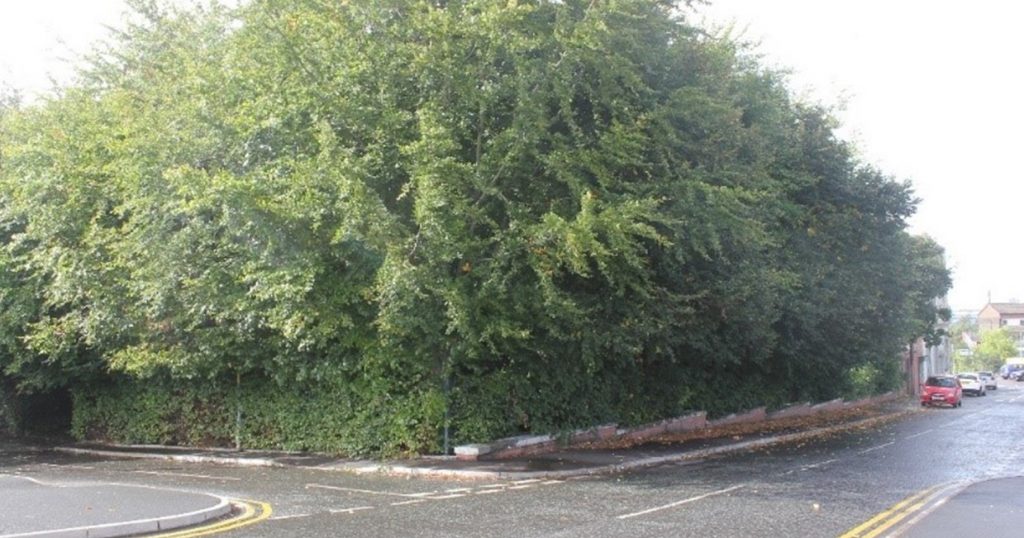
Site of the former Osborne Street Baths as it is now
Once the home of the Osborne Swimming Club
Photograph taken by Mark Evans
The complex consisted of three baths, the men’s first class bath (100 feet by 25 feet), the men’s second class bath (117 feet 6 inches by 28 feet 6 inches) and the women’s bath (56 feet by 22 feet 9 inches). There was a private wash house and laundry, a committee room and a suite of rooms for the superintendent. In an age when most house did not contain baths, the new building had 60 private baths for men and 17 private baths for women. 3

On a rainy Manchester day Collyhurst as it now
The view is taken looking towards where the Osborne Baths once stood
The photograph shows the area is no longer densely populated
Photograph taken by Mark Evans
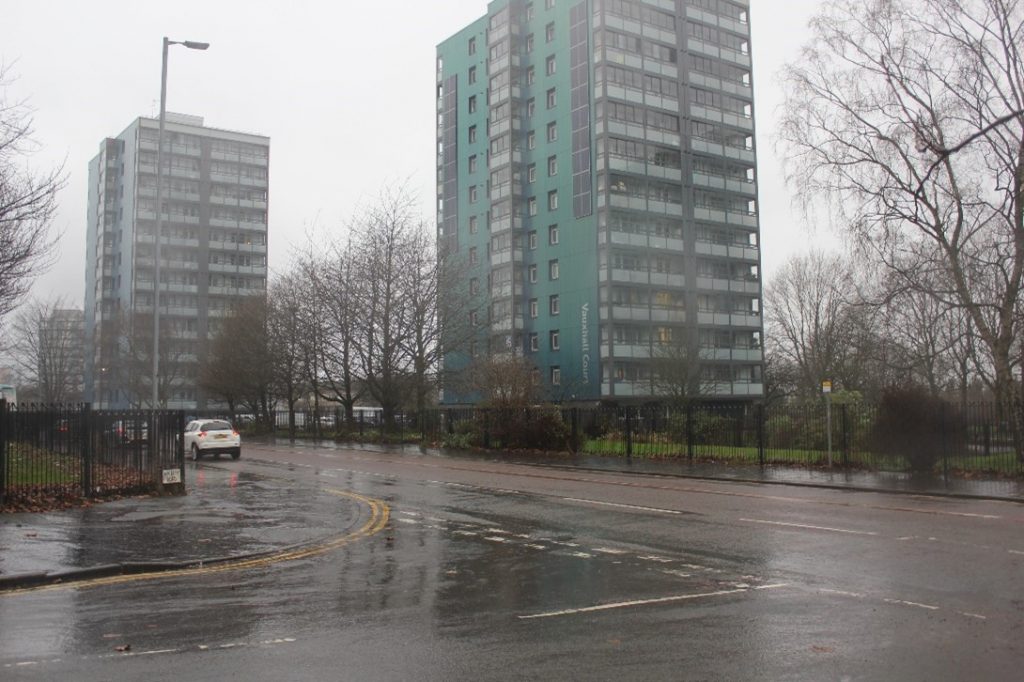
Rochdale Road, Collyhurst, looking towards Manchester and on the opposite side of the road to the previous photograph
The area has change a lot since the crowds would have lined up outside the Osborne Street baths to watch the Osborne water polo team play their latest match
Photograph taken by Mark Evans
An article in the Manchester Evening News on August 3, 1939 reported that Osborne Swimming Club was founded in 1887 with Sir Charles Schwann, as the president. However, it only had a short life span as by 1907 – 8 it had disbanded. 4. I suspect some sort of club followed but at this time this cannot be confirmed. Schwann was the MP for Manchester North from 1886 to 1918 and was also a Vice President for Newton Heath Lancashire and Yorkshire Railway Cricket and Football Club in the season 1888 – 89. 5. This club was eventually to become Manchester United.
One of the driving forces behind the water polo team and the swimming team was John Derbyshire, who was the superintendent at Osborne Street baths and became the secretary of the Osborne Club. His son, John Henry ‘Rob’ Derbyshire, became one of the finest swimmers and water polo players in the clubs and indeed countries history.
It is hard to believe now, as water polo gets very little coverage in the press, but at the end of the 1890s and the beginning of the 1900s the sport of water polo was extremely popular with large crowds packing pools around the country and particular in the Manchester region, although the game was popular in other areas such as Leicester and London.
The Osborne club began its run of success in 1892 when they won the first of their Northern Counties water polo championships. They went on to repeat the feat in 1893, 94, 95, 96, 98, 99, 1900 and 01. They also won the Manchester and District water polo championship (Division 1) from 1892 to 1902. The Manchester and District Swimming and Water Polo Association is Manchester’s local swimming Association. It was formed in 1891 and is still in existence but this year will merge with the two other local Associations, Bolton and Central Lancashire, to begin a new era in the areas swimming and water polo history.

Manchester and District Swimming and Water Polo Division 3 water polo medal dated 1900 won by Radcliffe Swimming Club
Similar ones will have been won by Osborne Swimming Club
They won the English Championship water polo title in 1894, 95, 96, 97, 98, 99, and 1901 and in 1900 a team representing Osborne won the Olympic gold medal at the Paris Olympic Games.
There has been some speculation on the members of the team that won the gold medal at the Olympics as it was thought they were all Osborne men. However, research has shown that in fact only two of the seven players who played at the Olympic tournament were Osbourne players – Thomas Coe who is listed as captain of the team and Peter Kemp, although there was a third Manchester player Robert Crawshaw who played for Manchester Mayfield and was born in Bury. 6 Coe took the place of Rob Derbyshire who was unable to travel to Paris. 7
The confusion I think is caused as the rules of the 1900 games meant that all the swimmers and water polo players had to be members of one club and with their record, Osborne Swimming Club, was chosen to represent England and so all the English competitors became members of the club for the Olympic tournament.
As previously noted coverage of the game in the press was widespread and now helps us to piece together some of the Club’s history. The reports indicate the game was very popular with large crowds watching. Many of the matches which were often preceded by a swimming gala of some form. Osborne’s games were often covered and some examples are now considered.
In the semi-final of the English Water Polo Championship in 1894 they played Nautilus, a London club, at Osborne baths. The team was listed as H. Silverdale, goal, W. Mills and T. Coe backs; T. Harris, half back; J. H. Tyers, W. Kay, and J . H. Hicks, forwards. The match was proceeded by a swimming gala in which Tyres tried to break the national record for the 1000 yards. He failed, giving up after 8 lengths although the timekeepers said he was on course to break the record. There were more races and a warm up water polo match between Osborne Reserves and the Rest of Manchester before the two semi-final teams entered the water at 10.20 pm!! A full night of entertainment for the crowd. Osborne won easily 12 – 0 with Tyres recovering from his swim to score four goals and Hicks scoring five.8 They went on to win the final, although, I have not yet found the result or who their opponents were.
In 1895 they faced Nautilus in the final and recorded a 13 – 1 victory. 9
In their 1896 national victory at Aston Baths, Birmingham, 10 their line-up had changed and only three players from their 1894 victory appeared. The line-up was E. T. Mountfield (goal), T. Harris (captain) and T Coe (backs), J. H. Blears (half-back), J. H. Derbyshire, J. H. Hicks and J. Lester. They faced a Leicester team which included J. A. Jarvis who had played for ‘Osborne’ at the 1900 Olympics. They won 3 – 0 to win the Championship for the third time in succession. 11
After their fourth national championship success in 1897 they won the national championship trophy outright and they presented it to the City of Manchester as a permanent memento of their progress. 12

The Osborne Shield, formerly the English Water Polo Shield
Currently on display at East Manchester Leisure Centre, Manchester, won outright by Osborne Swimming Club
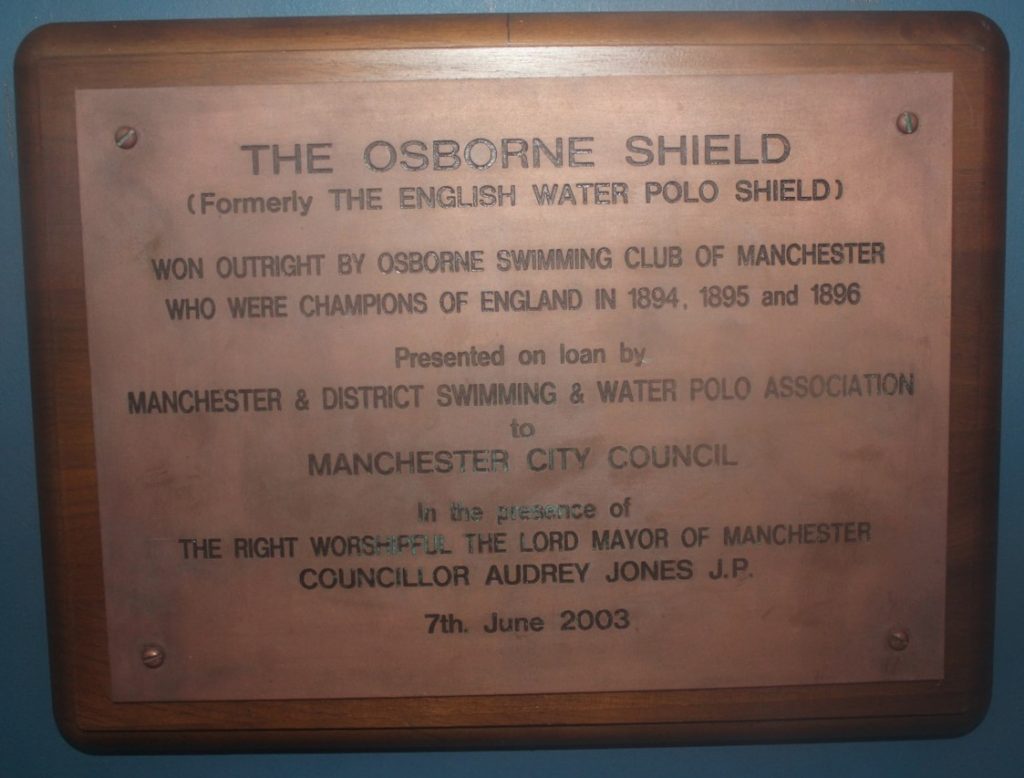
Plaque situated below the Shield with information about its history.
In 1898 English Water Polo Championship final Osborne played London Palace Swimming Club;
‘…in the presence of an enormous and enthusiastic crowd of spectators, at the Westminster baths.’ 13
They won 4 – 3 in a well contested game with the following team – J. Hammett, J. Robinson, J. W. Shaw, T. Coe, P. H. Lister, J. H. Derbyshire and W. H. Lister. Derbyshire scored all Osborne’s goals. It is worth noting that both the Listers, Coe, Robinson and Derbyshire had taken part in a swimming team race in which they beat a London team by three yards on the same night. 14
Osborne returned to London and to the Westminster baths for their final national championship success in 1901 where they defeated Worthing Swimming Club 6 – 2.
What exactly saw the demise of the club is not fully known but their success must have been a drain on their finances. At their annual general meeting in 1899 it was reported,
‘The Secretary (Mr. J. Derbyshire) has not been able to present a glowing balance sheet as ………there is a deficit of something like £10…….They have a true friend in Mr. John Craven, who will doubtless again assist them financially………They have a membership approaching 140….Their adverse balance is attributed to having to travel on two occasions to London for the final.’ 15
Although it appears they had a financial backer I suspect there would have been a limit to how much and for how long he could help. The club was travelling all over the country, which at the time must have been problematic for the players, who were amateurs and would no doubt have had full time jobs.
We know that in 1906 John Derbyshire took up the position of General Superintendent of Manchester Baths and Wash-houses based at the newly opened Victoria Baths. This involved looking after all the Manchester Baths and Wash-houses and included a luxurious flat at Victoria. Rob Derbyshire followed his father and went on to play for the Victoria Swimming Club. 16 The loss of these two great influences must have a significant impact on the Club. Other clubs in the Manchester area also began to emerge, for example, Hyde Seal, who went on to win the national water polo championships on a number of occasions. This also must have caused Osborne problems as players would swap clubs to play with the most successful teams. It would appear Osborne were no longer able to attract the top players and were unable to produce the stars as they did in their early years so leading to their demise.
Players
Let us take a brief look at some of the players who made the Osborne Club so successful, many of them Mancunians. Unfortunately, information on many of the players is limited, but I have chosen five players we know something about and I hope it gives an insight into how good they were.
Thomas Coe
Thomas Coe was one of the Club most important players. He was born in Manchester in 1873 and died in 1942. He worked in the family fruit business. His brother, John, was also a member of the Osborne Swimming Club. From what we can piece together he sounds like an interesting and intense character.

Thomas Coe, Osborne Swimming Club
Olympic gold medallist 1900
Like all the players in the team he was an excellent swimmer and won country and regional titles. He captained the Osborne water polo team for a number of years and also captained the England water polo team on a number of occasions and as we have mentioned won a gold medal in the 1900 Olympic Games.
However, perhaps showing how hard the game was, Coe became involved in an incident which perhaps was not the best advert for the game. In 1899 Coe was playing for Osborne against Hyde Seal in a friendly match, although it appears that Hyde Seal drafted extra players in for these friendlies, one being George Wilkinson, who has been described as one of the best players of his generation and it is thought, played for Osborne later in his career. It was claimed there was a crowd of around 1000 17 and Osbourne were beaten 5 – 3, a rare defeat for them, but
‘….play in the second half was very rough. Particularly in the goal mouth…Ultimately T. Coe and T. Wildgoose…..were ordered by the referee to leave the water, he having had frequently to warn other players against rough and irregular tactics.’ 18
It would appear that Coe was not happy with the decision and after the match Coe struck the referee, James Hunt in the mouth;
‘…violently ….damaging several teeth and cutting his lip.’
The assault resulted in an arrest and court appearance where Coe was fined £5.00 and bound over.19 He did offered to resign from Osborne but;
‘.. the committee of the Osborne Club express their keen regret at the incident, and strongly condemned it as disgraceful action. In view, however, of the splendid service he has rendered Osborne in the past, and the probable dealing with the case by the governing body, they decided not to accept his resignation.’ 20
Ironically when he retired from playing he went on to become a national referee!
James (Jack) H. Tyers
Tyers was probably better known as a swimmer where he achieved fantastic results winning all seven of the A.S.A. national titles in 1893 and 1894. The range of these events was from 110 yards to 5 miles showing what a versatile swimmer Tyers was. He also held a number of English swimming records. He played water polo for Osborne and England and was a prolific goal scorer. In a second round national water polo match in 1895 Osborne travelled to Bristol and defeated the home team 14 – 1 with Tyers scoring 7 goals. At the same meet he also swam a 107 yards swimming handicapped race in 1minute 11 seconds, which was a baths record. 21 In 1898 he turned professional and was no longer able to represent Osborne.
John ‘Rob’ Derbyshire
Derbyshire was the son of the Osborne Baths superintendent and was to become a major force in swimming and water polo circles of the time. He was born in Manchester on 29th November 1878. He was the English 100 yards champion in 1898, 99, 1900, 01, 03 and 04 and was the first Englishman to swim the distance in under a minute. He won the 220 yards champion in 1898, dead heated with F. Lane in 1900, won again in 1901 and 1903. He also won the 500 yards and half-mile in 1897. 22 Although, it was thought he played in the winning gold medal Osborne water polo team in 1900 we now know he did not make the trip, although, he did attend the 1906, 1908 and 1912 games, but as a swimmer and at the 1936 Games as the swimming team manager. He appeared many times for the Osborne water polo team winning a number of local, regional and national titles and made a number of international appearances for England’s water polo team some as captain. He was only 16 when he made his international water polo debut and went on to make nine appearances for England between 1895 and 1900 23.
Thomas Harris
Thomas Harris was yet another Osborne water polo player to captain England. Unfortunately, it is believed he retired just before the 1900 Olympic Games. He won a number of caps for England and was the captain of Osborne when they won the 1896 National water polo title. 24 One of his England caps was on Monday September 21st 1896 where he captained England at Westminster baths. They defeated Scotland 4 – 2 and he scored one of the goals. Also playing in this team was his Osborne team-mate, Rob Derbyshire and J. Hunt (Manchester Mayfield – the referee struck by Thomas Coe!!!) 25
Peter Kemp
Along with Thomas Coe Kemp was the second Osborne player to feature in the 1900 Olympic victory.

He began playing water polo for the Leander Club in London but when work brought him to the Manchester area he joined Osborne and featured in a number of their successes. He was an England international but did not stay too long with Osborne as he moved to Newcastle where he continued playing. 26
The achievements of the Osborne Club have now been largely forgotten and overshadowed by the footballs teams of United and City but in the 1890’s and early 1900’s many Mancunians were queuing up to watch water polo and the stars of the Osborne team. Most Mancunians now will never have heard of them but with the help of ‘Playing Pasts’, hopefully a few more might now know about some of the achievements and players.
Article © of Mark Evans
References
- Supplement to the Manchester Courier and Lancashire General Advertiser, June 16, 1883 p7
- Ibid
- Website – manchestervictorianarchitects.org.uk/buildings/Osborne-street-baths
- The Manchester Evening News, August 8, 1939
- Manchester. A Football History, Gary James, 2008 p70
- Playing Pasts article – John Henry ‘Rob’ Derbyshire, Osborne Swimming Club and the 1900 Olympic Water Polo Competition. Mark Evans 7th October 2019
- The Daily Telegraph, August 11, 1900
- Manchester Courier and Lancashire General Advertiser, September 6, 1894 p6
- The Evening News (Portsmouth) August 24, 1895
- The Sheffield Daily Telegraph, September 24, 1896
- The Sporting Life, September 26, 1896
- The Manchester Evening News, August 3, 1939
- The Daily Telegraph and Courier, October 21, 1898
- The Field, The Country Gentleman’s Newspaper, Vol 92, October 22, 1898
- Manchester Evening News, January 1920, 1899 p5
- Victoria Baths: Manchester’s Water Palace.
- The Manchester Evening News, June 14, 1899 p4
- Ibid
- Supplement to the Manchester Courier, July 1, 1899
- The Evening Star and Daily Herald, June 21, 1899 p2
- The Citizen (Gloucester), August 5, 1895 p not listed
- The Manchester Evening News, August 3, 1939
- West London Observer, December 2, 1938 p1
- Information from a relative of Thomas Harris
- London Evening Standard, September 22, 1896 p8
- The Athletic News, September 22, 1902 p8

